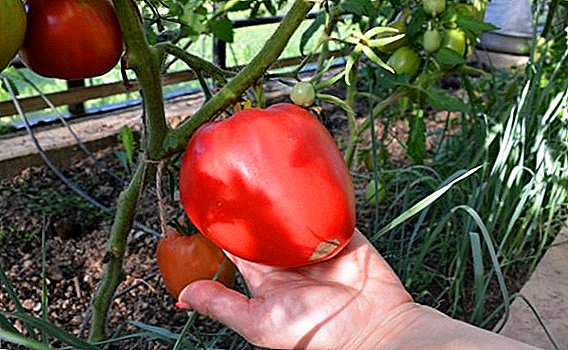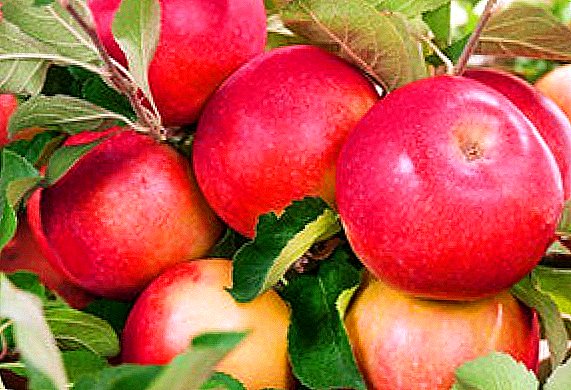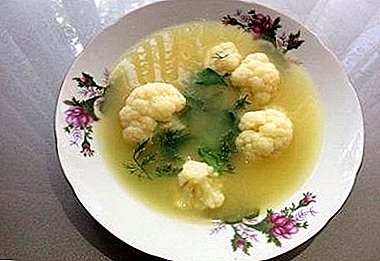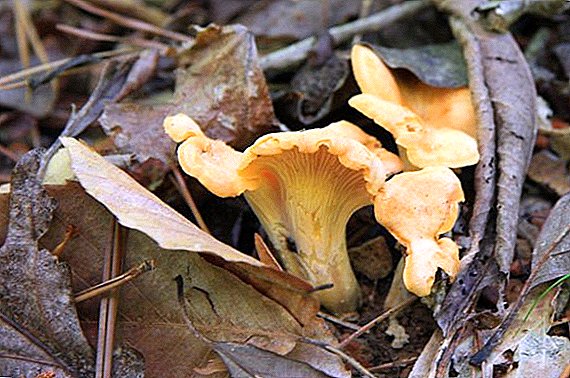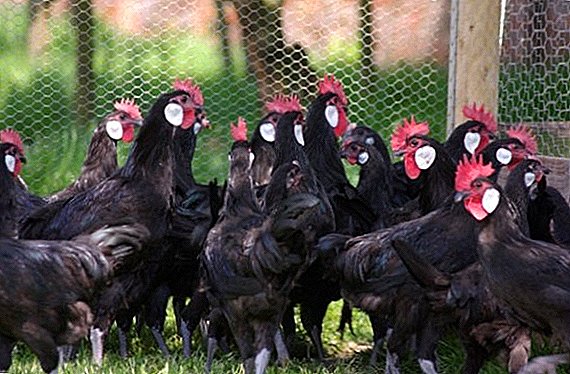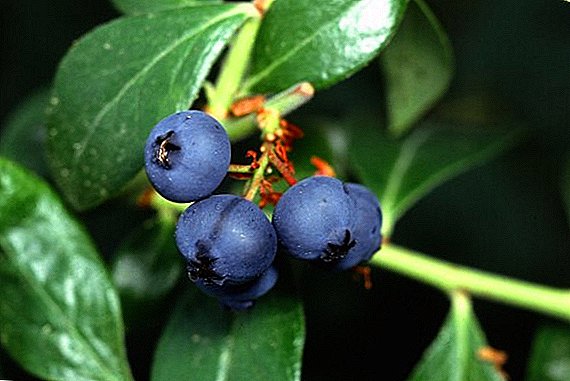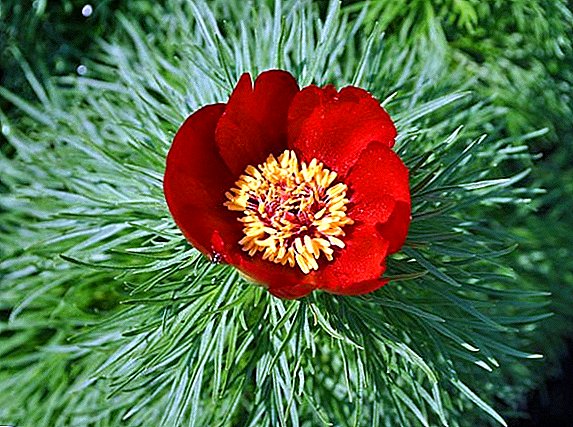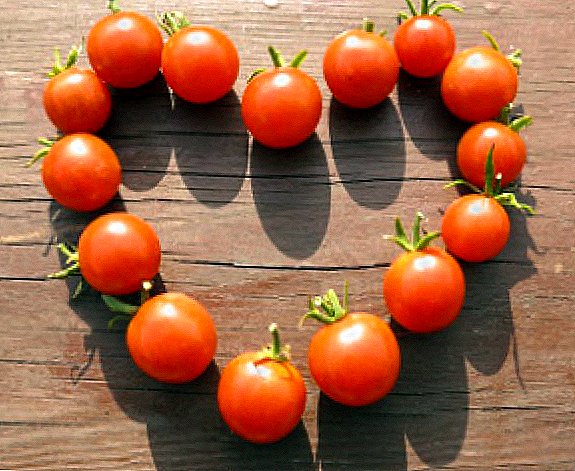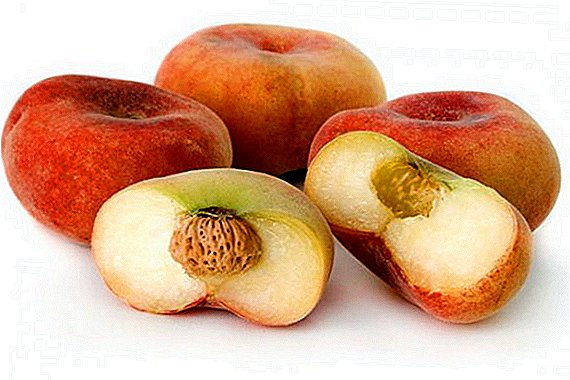 The most interesting thing in fig peach is that it has absolutely nothing to do with figs. Its flat shape, however, somewhat resembles a dried fig, as figs are also called, but it does not occur to anyone to call this peach fig. Somewhere else in the West, he is called a donut for the same flattened form. Let's find out more about this tasty and fragrant fruit.
The most interesting thing in fig peach is that it has absolutely nothing to do with figs. Its flat shape, however, somewhat resembles a dried fig, as figs are also called, but it does not occur to anyone to call this peach fig. Somewhere else in the West, he is called a donut for the same flattened form. Let's find out more about this tasty and fragrant fruit.
Botanical description
Contrary to the well-established folk beliefs, fig peach is not only not a hybrid of round peach and fig, but, in principle, cannot be such. According to scientists, these two species can not interbreed.

The homeland of this interesting fruit is China, and not at all Persia, as again can be judged by its name. And here the peach once again misleads us.
The fruit of the flattened form reaches 7 centimeters in diameter and 120 grams in weight. It is covered with a thin skin with a much smaller fuzz than that of its rounded brethren, which has a very sweet flesh of white or light cream shade. It has a slightly sour taste, and inside the pulp there is a small bone, which again distinguishes this species from other peaches.
Another useful feature of it is uniform distribution of taste throughout the depth of the pulp, while its rounded relatives taste somewhat weaker as it moves from the surface of the fetus to the bone.
Did you know? Experts have noticed an interesting fact: almost one hundred percent accurate indicator of the future well-being of any peaches is grapes. Where he feels good, peaches feel great there.
Chemical composition
The tasty pulp of this fruit is also saturated with many substances useful for human health. Among them - almost all members of vitamin B, as well as vitamins C, H, K, E, beta-carotene and a rather rare substance amygdalin, also called vitamin B17. He is suspected of being able to fight cancer problems.

It is a lot of essential oils in a fig peach, various organic acids and pectins. But this fruit is especially saturated with such valuable minerals as:
- potassium;
- calcium;
- chlorine;
- iron;
- magnesium;
- copper;
- fluorine;
- sodium;
- phosphorus;
- sulfur;
- manganese;
- chromium;
- zinc.
Calorie content
Although the fruit of this peach is sweet, however, its calorie content is low - only 60 kilocalories per hundred grams of product. This is facilitated by the complete absence of fat in the fruit, which makes it popular in the diet.

Varieties of fig peach
Breeders managed to bring several successful varieties of this plant, which differ in the area of cultivation, but are necessarily identical flattened shape of the fruit.
Learn more about the beneficial properties of fruits: pomegranate, fig, kumquat, feijoa, longan, medlar, kivano, guava, pineapple, arbutus, yoshta, goji, mulberry, strawberry, raspberry (black), black currant (red, white, black), plum , apricots, pears, apples, mandarin.
"Nikitsky flat"
The variety is characteristic in that that it is most adapted to cool climatic conditions. Its tree is low, sprawling, and the fruits reach 110 grams of weight and have a very delicate flavor. The plant brings the first fruits in mid-August.

"Vladimir"
This fruit has gained popularity with its gardeners. high yields and disease resistance. The tree, reaching average height, gives quite large fruits up to 180 grams, characterized by a very sweet taste and juiciness. They ripen in early August.

"Sweet Cap"
Characteristic features of this variety are early, in the third or fourth year, fruiting and simultaneous ripening of fruits in the middle of August. The fruits of this low tree have a sweet-sour taste and can reach a weight of up to 150 grams.

"UFO-3"
Although this variety is not resistant to cold and high yields, but it is valued for its annual yield stability. The tree itself can grow to a height of 2.5 meters, and the weight of the fruit reaches 110 grams. Their flesh contains pink veins and has a honey taste.

"Saturn"
This variety can withstand small frosts, and its fruits are less affected than others during transportation. His tree is high and sprawling, has the ability to start early to bear fruit and has a consistently high yield. Its fruits are small, reaching only 100 grams, but they have great taste.

Beneficial features
The presence in fig peaches of a large number of valuable substances for the body naturally makes this fruit one of the most popular fruits in the human diet. And for different categories of people he is good in his own way.
Read also about the beneficial properties and harm of nectarine and peach.
Ladies, he easily replaces heaps of pharmacy diet pills, which are not only expensive, but often harmful and more often useless. Being an excellent dietary tool to strengthen the body from the inside, this fruit can have a rejuvenating effect on the outside. Regular consumption of peach in the form of food, as well as the use of its pulp in masks and creams, significantly improves the appearance and condition of the skin, hair and nails in women.
Like women men, this fruit strengthens the immune system, tones the body, while improving the ability to focus its attention and develop memory. There are also specific, specifically for men properties of the fruit: it has a positive effect on male sexual functions, while simultaneously inhibiting the development of prostatitis.
Since the age of two, peach and children are shown. It normalizes the activity of the children's gastrointestinal tract, raises the tone of the body and, most importantly, activates the activity of the child’s immune system.
Did you know? In China, not only the fruits of the peach are widely used, but also its wood, making of them intricate bowls, which are very popular among the Chinese.
As practice shows, the use of fig peach is one of the best means to overcome toxicosis in pregnant women in the early stages of pregnancy. In addition, the solid presence in the fruit pulp of folic and pantothenic acids is extremely important for the normal development of the unborn child. And lactating mothers, this wonderful fruit, besides essential assistance in overcoming the depression occurring after giving birth, also noticeably activates lactation.
Doctors after long observations came to the conclusion that the use of fig peach can help in:
- normalization of the cardiovascular system;
- immunity strengthening;
- activation of the body's defenses against influenza and colds;
- normalization of the gastrointestinal tract;
- eliminating heartburn and constipation;
- the prevention of colon cancer and other cancers;
- eliminating excess weight;
- improve kidney, liver, biliary tract;
- overcoming depression;
- saturating the body with vitamins, microelements and useful acids;
- moisturizing and rejuvenation of the skin.
Also, the strengthening of immunity is positively influenced by: safflower, horseradish, garlic, savory, wild garlic, fir, black walnut, aloe, almond, white sturgeon, viburnum, cornel, Chinese magnolia, mint, basil, lemon balm.
Cooking Uses
It is noticed that when canning, this type of peaches is better than all other fruits. can preserve its useful properties. Cooks recommend preserving the fruit in sugar syrup. Like the apricots related to them, peaches are also dried, after which they retain useful substances almost completely.

In addition, these wonderful fruits are actively used in the manufacture of jam, compote, ice cream, jelly, jam and other desserts. They are widely used in the manufacture of confectionery. You can make different sauces and drinks from peaches, as well as add them to salads, meat and fish dishes, with which they are perfectly combined.
Harmful properties
This fruit has very few substances with harmful properties for the body. Is that amygdalin, or vitamin B17, which has the property in the body to be converted into toxic hydrocyanic acid. However, he is in this fruit in such meager amounts that there is no reason to speak of any harm to a person.

May bring health troubles and allergens contained in peach.
Please note that the organic compound amygdalin contained in the pits of turn, plum "Honey White", quince, cherry "Frost" and "Zhukovsky"
Contraindications
Contraindications in the use of fig peach most often boil down to limit its use by people with allergies. Together with apples and kiwi, this fruit belongs to the most allergenic fruit. Allergy-prone people with peaches can develop an oral type of allergy, in which the throat, lips and mouth become swollen, and a rash can appear on the skin.

It is not recommended to use this fruit also to people suffering from diabetes, as well as those who have an individual intolerance to this product.
For the treatment of diabetes mellitus is recommended to use such plants as: yucca, purslane, Crimean magnolia vine, aspen, as well as zucchini, gray walnut and boletus
How to choose a fruit when buying
To buy quality fruits, It is best to do this in a proven greenhouse or market. Supermarkets and hypermarkets rarely offer truly high-quality peaches.
Important! When choosing and purchasing a fruit, remember that a peach can last at room temperature for a maximum of 60 hours.
A good specimen should have a dense skin, and the fruit itself must be firm to the touch. The rotten parts immediately signal trouble with the freshness and preservation of the fetus.

Storage conditions
Keep these peaches in a cool and always calm place. since the fruits deteriorate very quickly when physically exposed to them. Fully ripened fruits quite successfully ripen on the lowest shelf of the refrigerator.
The rotted parts of the fetus seen in time must be cut out immediately, and the rest cut and placed in the freezer. But before that, it is necessary to remove the peel from the fruit, since at low temperature it can ruin the taste of the product with bitterness.

After thawing the fruit can not be held without drinking for more than 12 hours.
Growing fig peach
It is possible to grow this fruit with the help of seedlings, and from the seed. Naturally, the actions associated with planting, in both cases differ, but then the care of trees becomes almost the same.

Landing features
The main difference in the peach planting is that it is the original "seed" material - bone or seedling.
Check out the rules of autumn planting peach and care for him at this time.
Saplings
When purchasing seedlings in the first place, you must know what climate they are adapted to. Then you need to carefully examine the roots, which should not be damaged, and the place where the vaccination was carried out. It should not be any influx of other suspicious secretions.

The age of acquired seedlings is very significant, since the best survival rate is observed in annual specimens. From this and should proceed with their acquisition.
The place, which is planned for planting seedlings, should be prepared in the fall, carefully digging it. In the spring, they dig pits of a meter width and 80 centimeters in depth, fertilize the soil with organic matter and minerals, and pour a bucket of water into each hole. It is recommended a day before planting to dip the roots of a seedling in a solution of growth stimulant, and then the plant can be planted.
Read also about the peach planting peculiarities and how to care for them.
From bones
To grow a peach-bone tree, you need to take it out of the fruit, immediately place it in a glass of water and hold it for several days, periodically, every twelve hours, changing it. Then the bone should be dried, and, carefully smashing with a hammer, remove the nucleolus from it.

Kernels in a dark and cool place can be stored for a long time. And sow them best in the middle of autumn. Choosing a place that must meet the same criteria as for seedlings, the nucleoli should be planted into the ground to a depth of five centimeters.
Important! When drying and in any case, it is impossible to allow the sun to hit the bone - this can destroy the whole thing.
Location and lighting
Peach loves the sun and can not tolerate strong winds. Therefore, it should be planted on the south side of the garden in a place that is well protected from the winds, but is not in the shade of higher trees.

Experts advise against planting this fruit on the land where melons or deer crops, as well as strawberries or alfalfa were previously grown. Otherwise, there is a danger of infection of peach with a serious disease - verticillosis. It is useful to inquire about the depth of groundwater in this area. It is undesirable for them to be deeper than three meters.
It is also interesting to read about the features of the correct pruning peach.
Required temperature
Among all the peach figs their fellow is most resistant to low temperatures, although it is certainly not a northern plant. It has a characteristic property of late blooming and blooming, which allows it not to be afraid of spring frosts.

Humidity and watering
When not very shallow groundwater peach perfectly withstands drought. But still, insufficient intake of moisture from the upper layers of the earth adversely affects the yield. In an extremely hot summer, experts advise every two to three weeks to pour a couple of buckets of water under each tree.
Did you know? In China, the peach tree is a symbol of longevity, its branches adorn buildings for the New Year.
Soil and fertilizer
If the plant is not planted in chernozem, then it is recommended to fertilize the soil with organic matter in the form of compost and manure, as well as with mineral fertilizers: potassium, wood ash and superphosphate. And at chernozem only mineral fertilizers will suffice.

Top dressing
Plants need periodic feeding. But we must not forget that when planting in the ground, mineral and organic fertilizers are necessarily added. Therefore, in the first year the trees are exempt from fertilization, and then fertilizing in the form of organic matter is carried out throughout the growing season.
In the spring, each tree is recommended to feed with 75 grams of ammonium nitrate and 50 grams of urea. In the autumn, peach requires 40 grams of phosphate and 50 grams of potash fertilizer.
Every three years, the land in the circle wheel is made more fertile by adding ten kilograms of compost or manure.
Important! Before applying fertilizer, it is imperative to pour plenty of stem around the trunk to avoid burns and possible destruction of the tree.
Protection against diseases and pests
Diseases affecting stone fruit do not bypass the peach, although it has a higher immunity from pests. Most often the plant is affected by powdery mildew, gray mold, leaf curl, bloom and cytosporosis.
It also comes from pests such as aphids, fruit mites, weevils
Therefore, prophylactic spraying with disinfectant solutions and insecticides should be carried out regularly in early spring, immediately after pruning, during flowering and when the ovaries are formed, and the last time during a season the tree is sprayed in October.

Pruning
An important point in the formation of a well-developing and yielding high tree yield is pruning its branches. It is especially necessary in early spring, when it is possible to give the crown the necessary shape, removing the lateral branches and leaving a maximum of three skeletal branches.
Important! The crown of fig peach should look like a bowl.
Every year in March and October pruning for sanitary and anti-aging purposes. All dried, frozen or stuck branches should be removed, and the rest should be shortened to half a meter length. And in no case should we forget to lubricate the cuts with garden pitch.
Preparing for the winter
Before the onset of winter, the peach tree is necessary feed phosphate fertilizers and organic. Many experienced gardeners recommend to whiten tree trunks before winter.

The main protective action on the eve of winter is wood insulation Young peach trees must spud necessarily, for which the ground should be poured as high as possible around the trunk. After a week this land will settle a little, you need to warm it with wood shavings, dry needles or spruce branches. It is also good to wrap the trunks of young peaches in a non-woven fabric.
Learn how to deal with peach diseases and pests.
Difficulty growing
If you follow all the above rules for planting, care, feeding, trimming and prophylactic processing of fig peach, then his ability to resist cold and disease usually does not create problems for gardeners when growing it.

This wonderful fruit with a rich taste and delicate aroma, saturated with so many useful substances for humans, finds more and more of its fans at the shops and garden plantations. Fig peach confidently conquers its place in the sun, which he loves so much.


